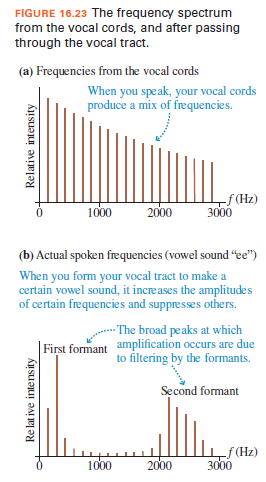FIGURE 16.23 The frequency spectrum from the vocal cords, and after passing through the vocal tract. (a) Frequencies from the vocal cords When you speak, your vocal cords produce a mix of frequencies. -f (Hz) 3000 1000 2000 (b) Actual spoken frequencies (vowel sound "ee") When you form your vocal tract to make a certain vowel sound, it increases the amplitudes of certain frequencies and suppresses others. · The broad peaks at which First formant amplification occurs are due to filtering by the formants. Second formant -f (Hz) 3000 1000 2000 Relative intensity Re lat ive intensity
FIGURE 16.23 The frequency spectrum from the vocal cords, and after passing through the vocal tract. (a) Frequencies from the vocal cords When you speak, your vocal cords produce a mix of frequencies. -f (Hz) 3000 1000 2000 (b) Actual spoken frequencies (vowel sound "ee") When you form your vocal tract to make a certain vowel sound, it increases the amplitudes of certain frequencies and suppresses others. · The broad peaks at which First formant amplification occurs are due to filtering by the formants. Second formant -f (Hz) 3000 1000 2000 Relative intensity Re lat ive intensity
Principles of Physics: A Calculus-Based Text
5th Edition
ISBN:9781133104261
Author:Raymond A. Serway, John W. Jewett
Publisher:Raymond A. Serway, John W. Jewett
Chapter14: Superposition And Standing Waves
Section: Chapter Questions
Problem 49P: Some studies suggest that the upper frequency limit of hearing is determined by the diameter of the...
Related questions
Question
100%
The first formant of your vocal system can be modeled as the resonance of an open-closed tube, the closed end being your vocal cords and the open end your lips. Estimate the frequency of the first formant from the graph of as shown, and then estimate the length of the tube of which this is a resonance.
Does your result seem reasonable?

Transcribed Image Text:FIGURE 16.23 The frequency spectrum
from the vocal cords, and after passing
through the vocal tract.
(a) Frequencies from the vocal cords
When you speak, your vocal cords
produce a mix of frequencies.
-f (Hz)
3000
1000
2000
(b) Actual spoken frequencies (vowel sound "ee")
When you form your vocal tract to make a
certain vowel sound, it increases the amplitudes
of certain frequencies and suppresses others.
· The broad peaks at which
First formant amplification occurs are due
to filtering by the formants.
Second formant
-f (Hz)
3000
1000
2000
Relative intensity
Re lat ive intensity
Expert Solution
This question has been solved!
Explore an expertly crafted, step-by-step solution for a thorough understanding of key concepts.
This is a popular solution!
Trending now
This is a popular solution!
Step by step
Solved in 2 steps with 2 images

Knowledge Booster
Learn more about
Need a deep-dive on the concept behind this application? Look no further. Learn more about this topic, physics and related others by exploring similar questions and additional content below.Recommended textbooks for you

Principles of Physics: A Calculus-Based Text
Physics
ISBN:
9781133104261
Author:
Raymond A. Serway, John W. Jewett
Publisher:
Cengage Learning

Physics for Scientists and Engineers, Technology …
Physics
ISBN:
9781305116399
Author:
Raymond A. Serway, John W. Jewett
Publisher:
Cengage Learning

College Physics
Physics
ISBN:
9781938168000
Author:
Paul Peter Urone, Roger Hinrichs
Publisher:
OpenStax College

Principles of Physics: A Calculus-Based Text
Physics
ISBN:
9781133104261
Author:
Raymond A. Serway, John W. Jewett
Publisher:
Cengage Learning

Physics for Scientists and Engineers, Technology …
Physics
ISBN:
9781305116399
Author:
Raymond A. Serway, John W. Jewett
Publisher:
Cengage Learning

College Physics
Physics
ISBN:
9781938168000
Author:
Paul Peter Urone, Roger Hinrichs
Publisher:
OpenStax College

University Physics Volume 1
Physics
ISBN:
9781938168277
Author:
William Moebs, Samuel J. Ling, Jeff Sanny
Publisher:
OpenStax - Rice University